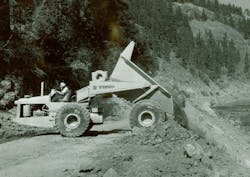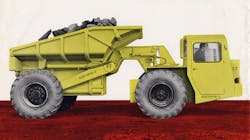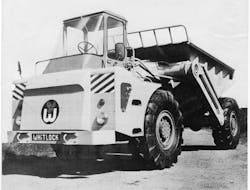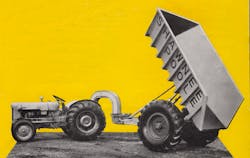Origins of the Modern Articulated Dump Truck
Articulated dump trucks are relative newcomers to the heavy construction industry, only gaining market acceptance in the 1970s—but its roots date back to the 1940s. Below are four forebears of the modern ADT.
The first articulated hauler was developed in 1944 when R. G. LeTourneau designed a rear-dump wagon for use with his Tournapull prime movers. It was a simple unpowered trailer, and it dumped by drawing the trailer axle toward the tractor, thus forcing the front of the dump box to tilt up. Formally introduced in 1947 as Tournarockers, they became part of an amazing line of fully interchangeable attachments for use behind Tournapulls. The largest Tournarocker was rated at 50 tons capacity, and was eventually phased out by successor Wabco in 1964 or 1965.
Northfield Industrial Fabrications Ltd. of Ossett, Yorkshire, England, is credited with developing the first true articulated dump truck: an integral, purpose-built hauler not designed for use with other attachments. A prototype was built in 1957 and introduced to the market in 1960. It had 180 degree articulation like the Tournarocker, but with modern hydraulics instead of LeTourneau’s system of electric motors, a speedy double-acting hydraulic dump, and a torque converter. It could carry 12 tons and move at 28 mph.
In 1963, Whitlock Brothers—one of several British firms manufacturing early ADTs—moved far ahead of the market with an unsuccessful hydrostatic drive ADT. It could carry 12 tons. With standard front axle power, it could move at 20 mph. In a look forward toward today’s ADTs, the operator could select all-wheel-drive to navigate poor ground conditions at up to 7 mph.
As a sidelight that also pointed toward future ADT features, H. G. Poole & Partners of Rhodesia designed a 10-ton capacity end dump wagon in the mid-1950s for use behind farm tractors. Stability was improved over other haulers by means of a frame-mounted gooseneck hitch that kept the center of gravity low while preserving excellent maneuverability.








